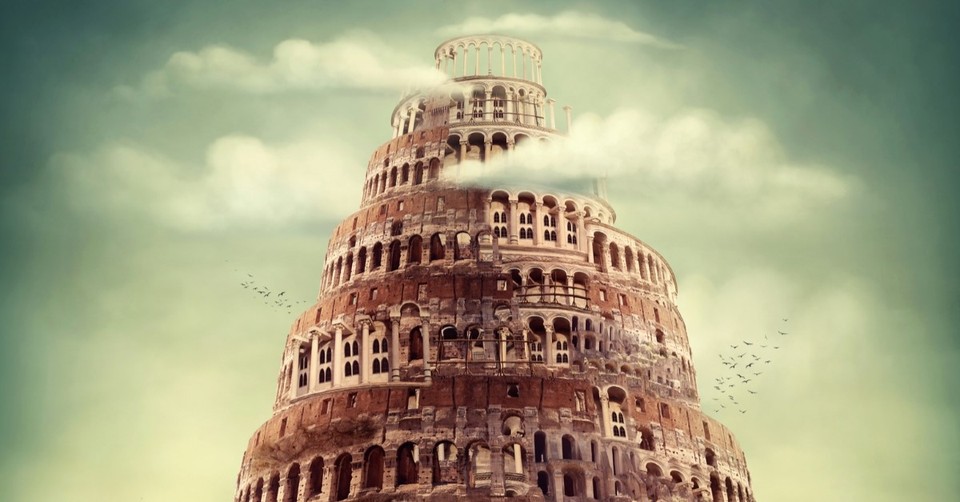Bible Catastrophes - The Tower of Babel

It was a time in the world when people held a fresh memory of the great Flood. Old man Noah and his sons told them all about it. Noah's son Shem preached to everybody, telling them to fear God and live for Him instead of living as people did before the Flood.
Noah's grandson Cush preached a different message. He became well known among the growing population for his anti-God preaching. He taught that the first age of the world ended with water, so people should build a tower to be higher than the water if a Flood came again. From the tower they also could study the sky to watch for a comet or other warning of a destruction.
Cush raised his son Nimrod to be a leader in this pagan plan and he did a good job of that. Nimrod led strong young warriors to kill monster animals that threatened the towns. This made him famous and adulated among the people. So with Cush's preaching and Nimrod's popular leadership, the time was right to get workmen together and build the tower. They also worked on building the walls and city that we now know as Babel or Babylon. They wanted everybody to live there under King Nimrod.
The Bible tells the next event in this story, and it shows us God's viewpoint rather than Cush's. It says: Go to, let us go down, and there confound their language, that they may not understand one another's speech. So the LORD scattered them abroad from thence upon the face of all the earth: and they left off to build the city (Genesis 11:7,8, KJV).
Most likely, preacher Shem wrote that original account of Babel. He was an eyewitness of those times, and he understood the ways God worked. Later, Moses used Shem's writings along with other ancient writings to compile the history that we have in the book of Genesis. Moses might have selected only a portion of what Shem wrote; we do not know about that. But sometimes we wish Moses had given more details. How did God destroy the tower? What happened to change people's speech and understanding?
One way to learn more is to study the lore of ancient peoples. Explorers, missionaries, and archeologists have found Babel stories practically everywhere in the world. Most people today think the stories are simply "myths" that somebody invented, maybe to explain languages. But some people, especially Bible believers, think they began as stories of the real event but became changed over the years as stories generally do.
Jewish priests in their Talmud say that "fire from heaven" destroyed the tower. Other peoples called it a thunderbolt. The Greeks and Romans both inherited stories of mighty winds that broke apart buildings and even mountains, and caused people to migrate. A Mexican story says that the people who survived this terrible catastrophe lost "their reason and speech." Job said that God removes speech and takes away understanding (12:20).
Other old documents from around the world seem to say that the planet Jupiter perturbed the planet Mercury, pushing it closer to the sun. God, of course, was in charge of all the planet movements. In its new orbit, Mercury came into close encounter with Earth. Their magnetospheres touched each other and caused a surge of electromagnetic power toward Earth. This is what the ancients called a thunderbolt. Could that thunderbolt affect people's language and thinking? Yes, it could. Today when people suffer electric shock or have electrodes applied to their brains, they can lose speech and memory. So that surge of power at Babel could be what affected the brains of Nimrod and his followers.
The Lord scattered the people from Babel. Their memory was impaired, their languages changed. They took along their pagan beliefs and worship practices, and spread them all over the world. False religions everywhere have enough similarities that they must all have a single origin. They began at Babel. Or perhaps they began even before the Flood, but in our post-Flood history we say that Babel was the origin of all paganism.
The first age had ended with water, the ancients said, and the second age ended with wind. People called those the age of water and the age of wind. With impaired memory, ancient peoples fearfully watched the skies for signs of a coming night, the end of an age. Many old structures like the Stonehenge in England were for the purpose of studying the stars. Today, many scientists and amateur astronomers have that same fear. They watch the skies for a comet or wayward asteroid. Occasionally they announce a sighting and everybody becomes excited. Will the new comet come close enough to cause damage?
During the scattering from Babel, some people migrated to Egypt. Earlier explorers may have been there already. At this time the rulers wanted something safer than the Babel tower that was intended to survive water but did not survive wind. So they built pyramids that would survive both, as well as quaking earth and fire from heaven. Entrances were high, to be above water. The "great gallery" and two chambers were higher yet. The enormously thick walls could protect from hurricanes, meteorites, and other violence. If one ceiling gave way, four others helped to absorb a shock. Two narrow channels slanting upward provided air circulation. They also provided a view of two standard points in the sky so occupants could observe whether the compass directions had changed—and if the weather had cleared. Beside the Great Pyramid at Giza, a Sphinx sat to guard against danger. It originally had the face of Horus, an early name for their planet-god Jupiter.
In spite of all that precaution, apparently something still went wrong in the pyramids. It could have been electrical discharges from violent cosmic storms, what the ancients called heavenly thunderbolts. The tall pyramids would attract like lightning rods. After the Old Kingdom of Egypt, later pharaohs stopped trying to build refuge shelters.
In many ways this theory of pyramid building fits the features of the pyramids and makes more Biblical sense than other proposals often printed in books. The structures did survive two big floods in Egypt, and they survived Earth convulsions, showing twisting effects from them. They have lasted better than any other structures in history.
But neither the pyramids nor the tower of Babel were as safe as being in the care of God—the true God who is in charge of Earth and skies.
Ideas for Bible Studty
- In family devotions or with siblings, read aloud the Bible account of the tower of Babel (Genesis 11:1-9).
- Can you list any other catastrophes in the Bible?
- Does the Bible mention any upheavals in the future of the Earth? Talk to your parents or pastor about this. (See Revelation 16:18 and 21:1.)
Ruth Beechick is a curriculum specialist who has written many Bible courses and several books and articles on ancient history. An easy-to-read book on the times of Babel is Adam and His Kin. A higher-level book is Genesis: Finding Our Roots She has also written how-to books for homeschooling parents. This article was originally published in the Jul/Aug '04 issue of Home School Enrichment Magazine. For more information, please visit https://HomeSchoolEnrichment.com.
Photo credit: Getty Images/egal
Originally published August 26, 2024.




